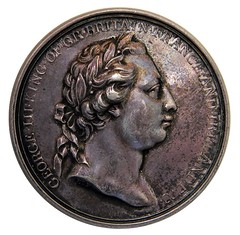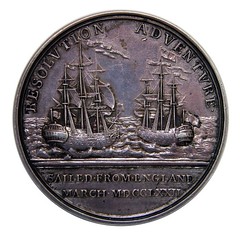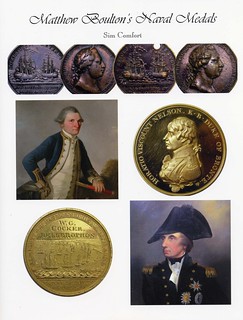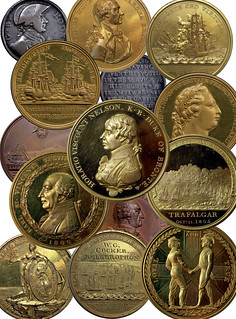
PREV ARTICLE
NEXT ARTICLE
FULL ISSUE
PREV FULL ISSUE
BOOK REVIEW: MATTHEW BOULTON'S NAVAL MEDALSChristopher R. McDowell submitted this great review of a new book on the naval medals of Matthew Boulton. Thank you! -Editor
Before I describe the book's contents, I would like to discuss its physical characteristics, which are eye-popping. As someone who has authored his own book and collected numismatic works for years, I have grown to appreciate this aspect of a book more and more. This book is of the highest quality. The only thing more I could possibly think to ask for would be leather binding. The book comprises 412 pages printed on Munken Arctic Matt White 90 gsm paper, with color images throughout. It is sewn bound as a quarto volume (11.25 inches x 8.65 inches) complete with a beautifully illustrated dust jacket. The print run was limited to 500 copies. I purchased my copy from Charles Davis's numismatic book website and my copy came signed by the author and hand-numbered – I received No. 50. I found this to be an unexpected and very nice touch. The book appears to be self-published. This makes sense as I doubt a modern publishing house would agree to produce such a handsome volume today. All the right choices were made by the author in his selections for what is clearly a labor of love. The book also includes a great index, which for my purposes as a researcher is greatly appreciated. What struck me most about the book's appearance, however, were the many rich color photographs. Every medal is depicted, plus many lovely historical images of people, places, and battles. I needed this book for a very limited research purpose. When it arrived, I turned to the index, found what I wanted, and went directly to that page. What I was looking for was there and I read it, then I read the next paragraph, and the next page until I stopped myself and decided to start from the beginning. Despite having a stack of books to read in my study, I began to read this book on Matthew Boulton naval medals that has little to do with my overall research or general interest (I do not collect naval medals) – the story, however, pulled me in and Sim's prose and illustrations kept me reading. I like to think of myself as a rather sophisticated numismatist, but every chapter brought new revelations to me. Matthew Boulton produced seven naval medals over the course of his life – the Otaheite (Resolution and Adventure), Admiral Rodney's St. Eustatia, Earl Howe's Glorious First of June, Davison's Nile, Ferdinand IV, Earl St. Vincent's, and his Trafalgar Medals. Each medal is discussed in detail. What makes a good numismatic book in my view are six things. 1) great illustrations; 2) a technical discussion of the numismatic items; 3) original research; 4) great writing; 5) an interesting story; and 6) placing the numismatic items into their proper historical context. Sim's book does all of these things. Matthew Boulton was a prodigious note taker and letter writer and his papers have largely been preserved. He was an entrepreneur to be sure, but he also had a great passion for engineering and mechanical processes. Sim has pulled from Boulton's writings the technical information regarding how he minted his naval medals. This is a great boon for researchers of the era. It is technical information like this, in my opinion, that makes a book a numismatic book rather than just a history or coin book. Let's face it, however, reading 400 plus pages of technical information on coins would be too much and if that is all the book had to offer I would have just read the few paragraphs I needed for my research and put it away in my library. The art of combining the technical with the historical story of the medals is what kept me reading. Fortunately, Boulton's rich paper trail permits us to follow the story of both the medals and general history closely and accurately. While others may enjoy a different aspect of the book, I particularly found the story of the Otaheite (Resolution and Adventure) medal fascinating. This medal was Boulton's first effort and it accompanied Capt. James Cook on his second exploratory voyage in 1772. The idea was to give the medals to indigenous people encountered on the voyage. Boulton manufactured this medal prior to his application of steam power to the medal and coin-making process. We view Boulton today as a man who produced superior medals in abundance, but forget his early ventures where he simply took what he knew from button manufacturing and applied it to medal-making. This was a period of trial and error for Boulton and by reading this story I was able to learn a great deal about early coin and medal manufacturing that I believe is directly applicable to American Colonial numismatics. I also learned a great deal about Matthew Boulton and came away impressed by his ability to overcame adversity and learn from his mistakes and grow as a coin and medal-maker.   Each of Boulton's naval medals has a similar technical and historical account behind it and Sim's captures all these stories in a compelling way. The reader also gets a direct connection with the past as Sim's world-class collection of medals includes what must be the greatest assemblage of medals engraved with the recipients' names ever gathered. I did not even know such things existed! Here are images of medals with the inscribed names of the men who fought at Trafalgar and other great battles along with their personal stories. Many of the sailors cherished their medals so much they wore them around their neck or carried them in specially designed cases; produced, of course, by Mr. Boulton, who seldom let a business opportunity pass. With that said, the Trafalgar medals were all made at Boulton's personal expense after he realized that the common sailor was to receive no award or memento of the great battle. I will be keeping a sharp eye out for these medals in the future. Fortunately, Sim gives hints as to how to spot spurious naval medals – something greatly appreciated by this novice medal collector. I would be remiss if I did not add one final thing about Sim Comfort. After reading the book, and already deciding to write this review, I realized I needed an image of the rim of one of the naval medals for my research. This particular medal's rim was not illustrated in the book, although many others are. I located Sim's email in London and sent him a message telling him how much I liked his book and asked him if he would please photograph the rim of this very rare medal for me and send it to me for my research. I realize this was an unusual request from a total stranger, but I had no other means of acquiring what I needed. Within 24 hours Sim responded to me, answered my questions, took the photograph I requested, and sent it to me for my use. Therefore, I can attest that in addition to writing one of the best numismatic books I have ever read, I can say that Sim Comfort is an outstanding and approachable gentleman willing to help a fellow numismatist in need. I really cannot say enough about the book or Sim. I give this book my highest recommendation – 5 stars! Here is some more information from the author's web site. NOTE: the book is available in the U.S. from numismatic literature dealer Charlie Davis. -Editor
Written by a collector for other collectors and museum curators, this work will no doubt prove a valuable reference for all interested parties. It is with the support of Britain's major museums that this publication has been made possible. ISBN 978-0-905887-11-1 The book comprises 432 pages printed on Munken Arctic Matt White 90 gsm paper, with colour throughout. It is sewn bound as a quarto volume (28.5 cm / 11.25 inches x 22 cm / 8.65 inches) complete with dust wrapper. The limited edition of 500 copies is available for £125.00 plus postage. To order, please email for payment details and shipping costs to sim@simcomfort.co.uk or telephone us in England on 44 (0) 20 8944 8747. For more information, or to order, see: UK: Matthew Boulton's Naval Medals (http://www.simcomfort.co.uk/matthew_boulton.htm) US: Comfort: Matthew Boulton's Naval Medals
(https://www.vcoins.com/en/stores/charles_davis/44/product/  Wayne Homren, Editor The Numismatic Bibliomania Society is a non-profit organization promoting numismatic literature. See our web site at coinbooks.org. To submit items for publication in The E-Sylum, write to the Editor at this address: whomren@gmail.com To subscribe go to: https://my.binhost.com/lists/listinfo/esylum All Rights Reserved. NBS Home Page Contact the NBS webmaster 
|

